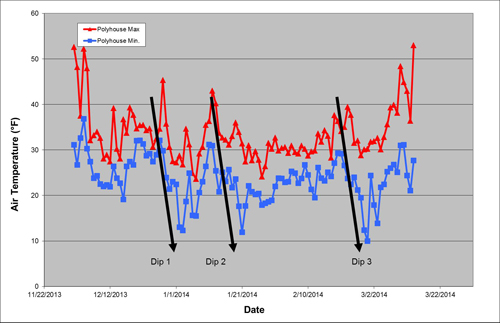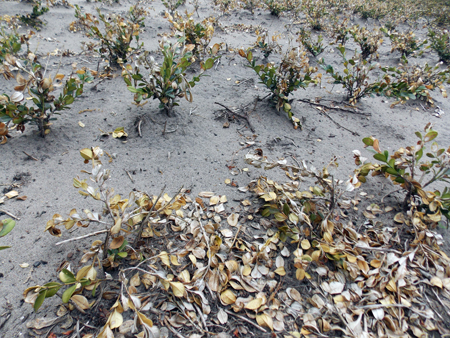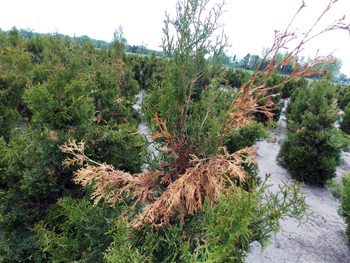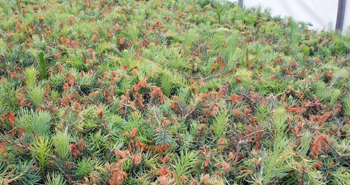Winter injury continues to show up in commercial nurseries
The excessively low temperatures and long duration of this past winter caused freezing, desiccation or frost damage on 23 species of evergreen and deciduous species in West Michigan nurseries.

The winter of 2014 was excessively cold, and air temperatures in West Michigan were below 32 degrees Fahrenheit for long stretches of time and dropped below -10 F 10 times. Michigan State University Extension educators visited nursery growers in Ottawa County to assess the damage in late May as winter-related damage continued to become evident in commercial nurseries. Twenty-three species of evergreen or deciduous trees and shrubs were reported to have winter or frost damage (Table 1). Much of the damage observed on nursery stock was in polyhouses over the winter.
Table 1. Species of nursery crops in West Michigan with winter injury.
|
Common name |
Scientific name |
|
Concolor fir |
Abies concolor |
|
Japanese fir |
Abies firma |
|
Turkish fir |
Abies nordmanniana |
|
Red maple |
Acer rubrum |
|
Barberry |
Berberis |
|
Boxwood ‘Green Velvet,’ ‘Winter Jem,’ and ‘Green Mountain’ |
Buxus |
|
Redbud |
Cercis canadensis |
|
Kousa dogwood |
Cornus kousa |
|
St. John’s Wort |
Hypericum perforatum |
|
Holly ‘Prince’ and ‘Princess’ |
Ilex × meserveae |
|
Soft Touch Holly |
Ilex cranata |
|
Inkberry |
Ilex glabora |
|
Tamarack larch |
Larix laricina |
|
Yellow delicious apple |
Malus domestica |
|
Russian cypress |
Microbiota decussata |
|
Pitch pine |
Pinus rigida |
|
Japanese black pine |
Pinus thunbergii |
|
Virginia pine |
Pinus virginiana |
|
Emerald beauty arborvitae |
Thuja occidentalis |
|
Juniper |
Thuja occidentalis pyramidalus |
|
Western cedar |
Thuja plicata |
|
Eastern hemlock |
Tsuga canadensis |
|
Doublefile viburnum |
Viburnum plicatum |
In order to understand the winter injury to those plants in hoophouses, MSU Extension examined the MSU Enviro-weather data from a polyhouse in West Olive, Michigan (Fig. 1). This station includes sensors which continually record air temperatures and other variables inside an operational nursery polyhouse. During the winter there were three pronounced temperature cycles where air temperatures in the polyhouses dropped as low as 10 F (Fig. 1). The cycling of temperatures with each outbreak of Artic air caused desiccation and freezing injury on many nursery crops. Some nursery crops that were killed in polyhouses, such as Virginia pine, Western cedar and Doublefile viburnum, had direct freezing damage which killed the plant tissues.
Figure 1. The average maximum and minimum air temperatures in a polyhouse at the West Olive Enviro-weather station.

Credit: Bert Cregg and Heidi Wollaeger, MSU
In addition to plants inside polyhouses, field-grown nursery crops and container plants that were over-wintered outside also had significant damage. Boxwoods ‘Green Velvet,’ ‘Winter Jem’ and ‘Green Mountain’ grown in the field all suffered cold injury, or sublethal damage, and additional branch breakage due to the snow load (Photo 2). Many branches of the field-grown Emerald Beauty Arborvitae broke under the 90-plus inches of snow that fell in Ottawa County (Photo 3). While most species experienced direct cold injury or freezing damage to the entire plant, other plants only had damage to sensitive new growth such as buds or tender new shoots. For example, Concolor fir (Photo 4) had frost injury which killed the new shoots.
Photo 2. Boxwood species with cold injury and broken shoots due to heavy snow loads. Photo credit: Heidi Wollaeger, MSU Extension
Photo 3. Branches of field-grown Emerald Beauty Arborvitae broke under the heavy snow loads. Photo credit: Heidi Wollaeger, MSU Extension
Photo 4. Frost damage on Concolor fir. Photo credit: Heidi Wollaeger, MSU Extension
Nursery growers who experienced winter injury on woody crops should assess the damage of each plant and prune out the dead growth if the plant can still be saleable. For conifers and other trees, corrective pruning and staking may be needed to promote a central leader and restore tree form. In many cases, however, plants with severe die-back will be unsalable and should be discarded.
In order to prevent a similar occurrence next year, one nursery grower reports that they will now be moving fruit trees and other cold sensitive plants into overwintering houses to prevent the cold injury and trunk splitting observed from this winter. If growers experienced significant losses of a species, they should re-analyze the hardiness of plants along with their profit margins on them during a normal growing season.
Dr. Cregg’s work is funded in part by MSU’s AgBioResearch.



 Print
Print Email
Email




